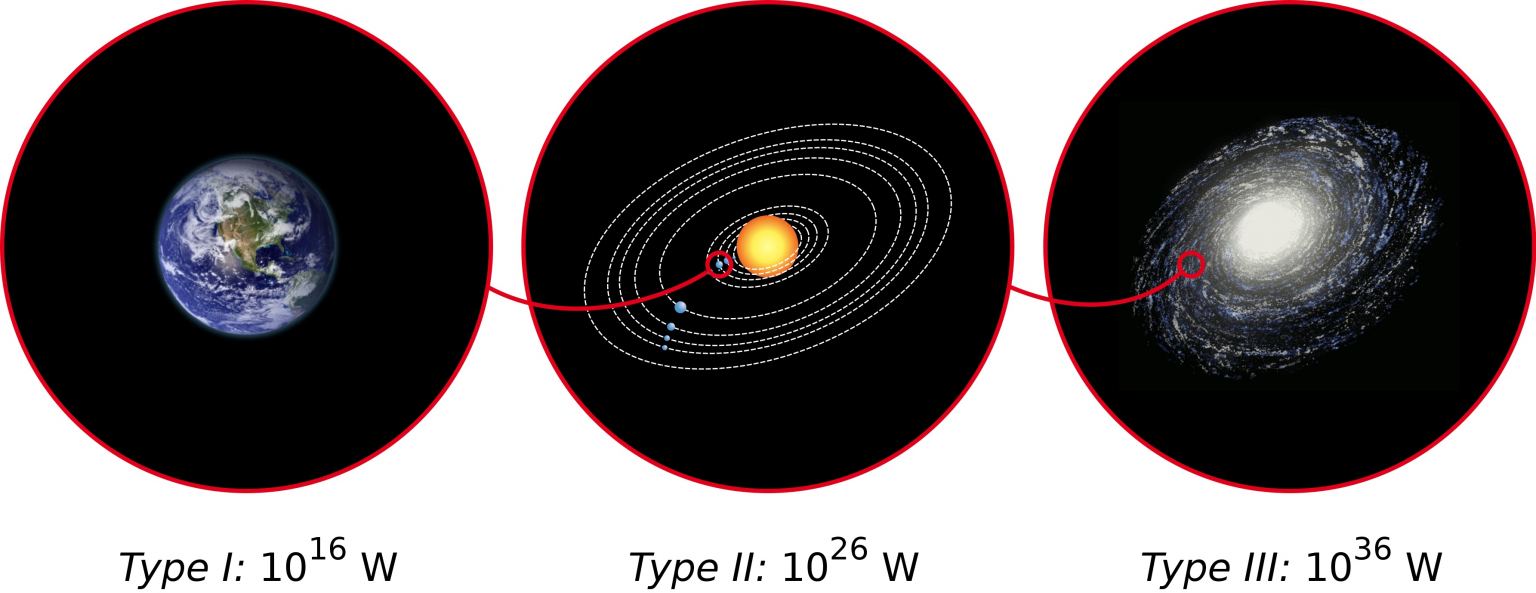
Artist's impression of a Dyson Sphere, which could signal a Type II civilization. (cokada/iStock/Getty Images Plus)
BRIAN KOBERLEIN,
UNIVERSE TODAY
20 APRIL 2022
There are several ways we can measure the progress of human civilization. Population growth, the rise and fall of empires, our technological ability to reach for the stars.
But one simple measure is to calculate the amount of energy humans use at any given time. As humanity has spread and advanced, our ability to harness energy is one of our most useful skills.
If one assumes civilizations on other planets might possess similar skills, the energy consumption of a species is a good rough measure of its technological prowess. This is the idea behind the Kardashev Scale.
Russian astrophysicist Nikolai Kardashev proposed the scale in 1964. He categorized civilizations into three types: planetary, stellar, and galactic.
A Type I species is able to harness energy on a scale equal to the amount stellar energy that reaches its home planet. Type II species can harness energy on the scale of its home star, and Type III can harness the energy of its home galaxy.
The idea was further popularized by Carl Sagan, who suggested a continuous scale of measurement rather than simply three types.
So what type of civilization are we? Although humans use a tremendous amount of energy, it turns out we don't even qualify as Type I.
About 1016 Watts of solar energy reaches Earth on average, and humanity currently uses about 1013 Watts. On Sagan sliding scale, that puts us currently at about 0.73.
Not bad for a bunch of evolved primates, but it raises an interesting question. Could we even reach Type I? After all, we can't capture all the sunlight that reaches Earth and still have a habitable planet.

20 APRIL 2022
There are several ways we can measure the progress of human civilization. Population growth, the rise and fall of empires, our technological ability to reach for the stars.
But one simple measure is to calculate the amount of energy humans use at any given time. As humanity has spread and advanced, our ability to harness energy is one of our most useful skills.
If one assumes civilizations on other planets might possess similar skills, the energy consumption of a species is a good rough measure of its technological prowess. This is the idea behind the Kardashev Scale.
Russian astrophysicist Nikolai Kardashev proposed the scale in 1964. He categorized civilizations into three types: planetary, stellar, and galactic.
A Type I species is able to harness energy on a scale equal to the amount stellar energy that reaches its home planet. Type II species can harness energy on the scale of its home star, and Type III can harness the energy of its home galaxy.
The idea was further popularized by Carl Sagan, who suggested a continuous scale of measurement rather than simply three types.
So what type of civilization are we? Although humans use a tremendous amount of energy, it turns out we don't even qualify as Type I.
About 1016 Watts of solar energy reaches Earth on average, and humanity currently uses about 1013 Watts. On Sagan sliding scale, that puts us currently at about 0.73.
Not bad for a bunch of evolved primates, but it raises an interesting question. Could we even reach Type I? After all, we can't capture all the sunlight that reaches Earth and still have a habitable planet.

Three types of Kardeshev civilizations. (Wikipedia, cc-by-sa 3.0)
This question is studied in a paper recently posted to the arXiv. The paper looks at the three primary sources of energy: fossil fuels, nuclear, and renewable, and calculates their potential growth over time.
On the one hand, reaching Type I would seem pretty easy. Make the production of energy your top priority, and you'll get there in the end. But each type of energy source has its limitations.
In an extreme case, such as burning every ounce of fossil fuel we can, it could lead to a level of climate change that could end us all in a so-called Great Filter. You can't become a Type I civilization if you're extinct.
So the team takes a more nuanced approach, analyzing the physical limitations of each type of energy source, and balancing them against the need to limit climate change and pollution levels as outlined by the United Nations Framework Convention on Climate Change and the International Energy Agency.
They found that even with realistic limitations, it is possible for humanity to reach a Type I level. The downside is that we won't reach that level until at least 2371.
That isn't necessarily a bad thing. The Kardashev Scale is a very blunt tool for measuring the scale of human technology.
While advanced civilizations require significant energy, we have seen how advances in low-power computing and increased efficiency allow us to decrease or flatten our energy consumption while continuing to advance technologically.
While this study shows how we could become a Type I civilization, it's possible that we'll be truly advanced when we realize we don't need to.
This article was originally published by Universe Today. Read the original article.
This question is studied in a paper recently posted to the arXiv. The paper looks at the three primary sources of energy: fossil fuels, nuclear, and renewable, and calculates their potential growth over time.
On the one hand, reaching Type I would seem pretty easy. Make the production of energy your top priority, and you'll get there in the end. But each type of energy source has its limitations.
In an extreme case, such as burning every ounce of fossil fuel we can, it could lead to a level of climate change that could end us all in a so-called Great Filter. You can't become a Type I civilization if you're extinct.
So the team takes a more nuanced approach, analyzing the physical limitations of each type of energy source, and balancing them against the need to limit climate change and pollution levels as outlined by the United Nations Framework Convention on Climate Change and the International Energy Agency.
They found that even with realistic limitations, it is possible for humanity to reach a Type I level. The downside is that we won't reach that level until at least 2371.
That isn't necessarily a bad thing. The Kardashev Scale is a very blunt tool for measuring the scale of human technology.
While advanced civilizations require significant energy, we have seen how advances in low-power computing and increased efficiency allow us to decrease or flatten our energy consumption while continuing to advance technologically.
While this study shows how we could become a Type I civilization, it's possible that we'll be truly advanced when we realize we don't need to.
This article was originally published by Universe Today. Read the original article.
No comments:
Post a Comment